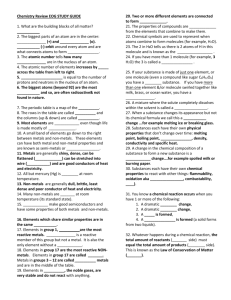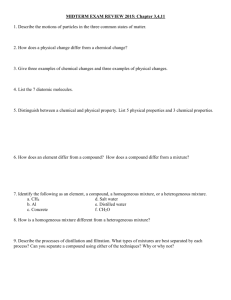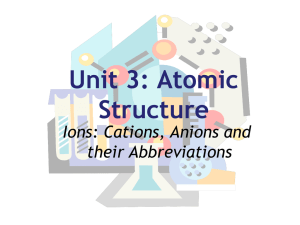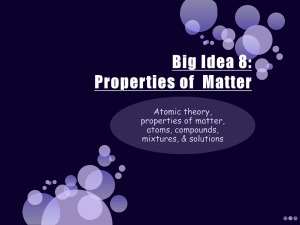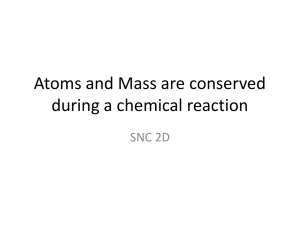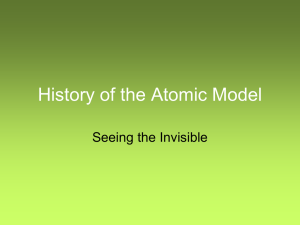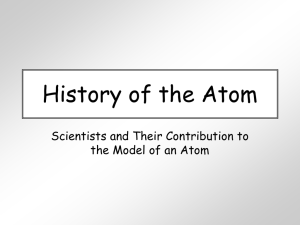Additional Chemistry
advertisement
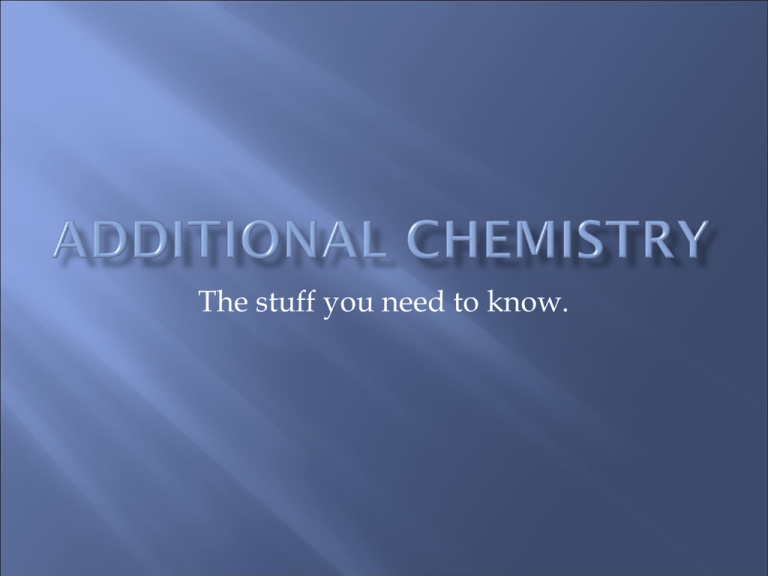
The stuff you need to know. Particle Mass Charge Proton 1 +1 Neutron 1 0 Electron 0 -1 ATOMIC MASS 12.0 6 C ATOMIC NUMBER As long as you know the differences between the particles in an atom the PT can tell you how many each contains. Atomic Mass = Protons + neutrons. Atomic number = Protons (electrons) Atom Sodium Chromium Nitrogen Oxygen. Protons Neutrons Electrons 1 GROUPS 2 3 4 5 6 7 PERIODS 1 2 Non metals 3 4 Metals MAKING BONDING EASIER: GROUP NUMBER = Knowing the periodic table will help you first work out what bonding is taking place (ionic, covalent or metallic). The number of electron on the outer shell It will also help you to get the atomic structure of each atom right. PERIOD NUMBER = The number of shells 8 Type of Bonding Between what atoms Characteristics Properties IONIC Non Metals Metals Electrons are exchanged, metal atoms give them to the non metal atoms producing ions Large crystals with high melting points that will conduct electricity when molten or dissolved. COVALENT Non Metals – Non The non metals share pairs of Metals Either small molecules like CO2 or giant crystals like diamond. Metals - Metals Shiny, good conductors of heat and electricity. electrons METALLIC Metals lose their spare electron to a sea of delocalised electrons around the positive metal ions Draw the structures of each atom and then show the bonding that would occur. 1. Magnesium and Chlorine to form Magnesium Chloride. 2. Nitrogen and Hydrogen to form Ammonia. As each atom has a mass so does a molecule made from different atoms. This is MOLECULAR MASS (The mass of a molecule). We can work out molecular mass by simply adding together the masses of the atoms that make a molecule 1. 2. 3. What are the masses of the following? H2SO4 CaCO3 Mg(OH)2 The reason we call the masses of atoms and molecules relative masses is because they are relative to each other (we don’t need to compare them to anything else) We make use of this when using MOLES Atom economy is a measure of the amount of useful stuff we get from a reaction. CaCO3(s) → CaO(s) + CO2(g) To find the atom economy we divide The useful stuff from the relative mass of useful stuff by the this reaction is CaO relative mass of everything used and times by 100 Mr of useful products Atom economy = × 100 Mr of all reactants 56 100 56% 100 We use MOLES to work out how much stuff will be either needed, or made during a chemical reaction. A MOLE OF ANY ATOM OR MOLECULE IS EQUAL TO ITS ATOMIC MASS OR MOLECULAR MASS IN GRAMS. 1 MOLE OF ANY SUBSTANCE WILL ALWAYS CONTAIN THE SAME NUMBER OF PARTICLES (6.023 × 1023) Mass Moles Ar / Mr Work out the number of moles in the following: 1. 80g of Copper sulphate (CuSO4) 2. 5.75g of Sodium metal (Na) Fe2O3(s) + CO(g) → Fe(s) + CO2(g) Make a list of the number of atoms on each side. Fe × 2 O×4 C×1 Fe × 1 O×2 C×1 Try to find the easiest one to balance first Fe2O3(s) + CO(g) → 2Fe(s) + CO2(g) Keep working at it changing the numbers as you go and eventually you will crack it Fe × 2 O×4 C×1 Fe × 2 O×2 C×1 Sometimes you can’t balance one thing without changing another Fe2O3(s) + 3CO(g) → 2Fe(s) + 3CO2(g) (s) = solid (l) = liquid (g) = gas (aq) = Solution ‘For a reaction to occur particles must collide with sufficient energy to overcome the activation energy of the reaction.’ Condition Effect Raising the Temperature Particles move around faster so they collide more often and with more energy. Increasing the concentration / Pressure There are more particles in an area so they collide more often. Increasing the surface area There are more surfaces available for the particles to collide with. Adding a catalyst. Lowers the activation so more particles have enough energy to start a reaction. Positive electrode (Anode) Negative electrode (Cathode) Negative ions are attracted to the anode where they give up their electrons and become oxidised Positive ions will be attracted to the cathode where they will gain electrons and become reduced Eg: Eg: 2Cl-(aq) → Cl2(g)+ 2e- Cu2+(aq) + 2e- → Cu(s) You need to know how electrolysis is used in: •The production of Aluminium •The purification of Copper •Production of Hydrogen, Chlorine and Sodium Hydroxide from Brine N2(g) + 3H2(g) ↔ 2NH3(g) In Reversible reactions products are able to turn back into reactants -92kJmol-1 They will eventually reach a state of dynamic equilibrium where the products are turning back into reactants as fast as they are produced If you change the conditions of an equilibrium it will try to change them back! 1. Increase the temperature and it will try to lower it by using the endothermic reaction and visa versa. 2. Increase the pressure and it will make less molecules in order to decrease the pressure again and visa versa. 3. If you add more of anything in the equilibrium it will move the other way to get rid of it and visa versa. •Acids are substances that donate Hydrogen ions (H+) •Acids can be both strong and weak. H2SO4 → 2H+ + SO42•Bases are solids or liquids that neutralise acids •They are able to accept Hydrogen ions (H+) •They can be Metal Hydroxide or Metal Oxides HCl(aq) + NaOH(aq) → NaCl(aq) + H2O(l) CuO(s) + 2HCl(aq) → CuCl2(aq) + H2O(l) Salts are produced in neutralisation reactions, most are


